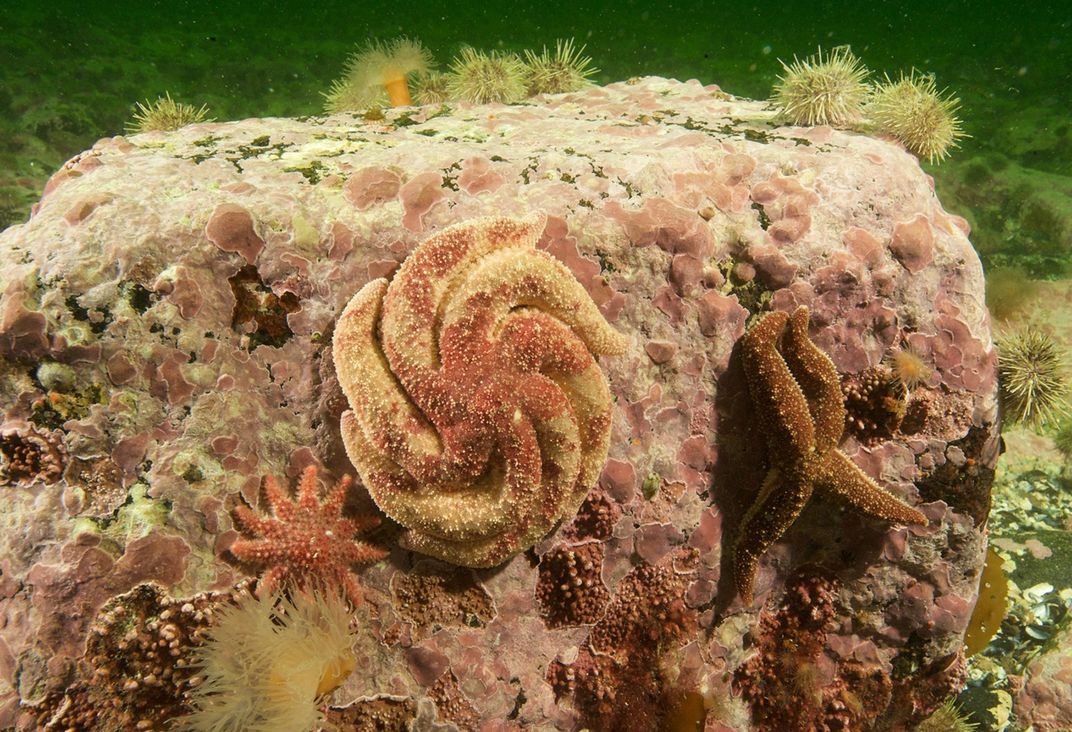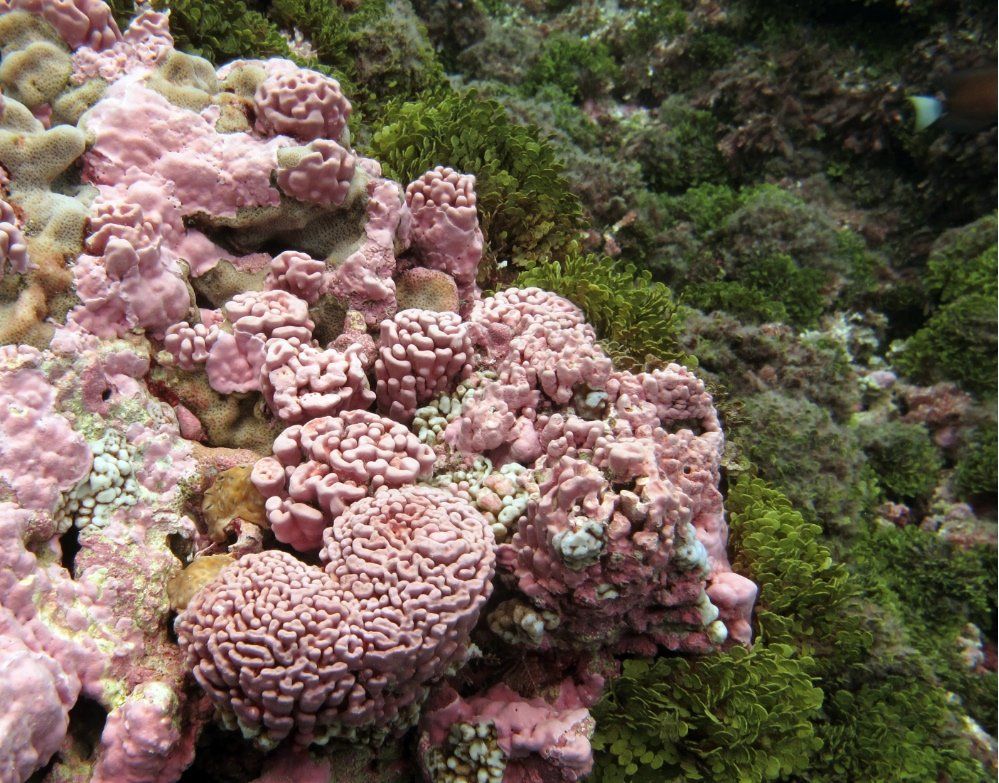In Its Layers, This Stunning Pink Coralline Algae Holds Secrets of Climates Past
Unseen and unsung for centuries, these underwater species of coralline algae are providing scientists with an unparalleled new archive of information
/https://tf-cmsv2-smithsonianmag-media.s3.amazonaws.com/filer/ab/1c/ab1c1f3e-ea41-4a6d-ae71-b184f90cab6e/nhb201602677web.jpg)
We have all seen by now the image of the polar bear, its commanding presence diminished by isolation on a bitterly small fragment of ice, surrounded by a cobalt sea that shouldn’t be there. As a symbolic expression of rapid climate change, it’s undeniably compelling.
But if you really want to get a better understanding of what’s happening in the Arctic and Subarctic, you must admire, instead, an organism far more humble and unfamiliar than the polar bear: the coralline algae of the genus Clathromorphum.
They’re not algae like one typically thinks of, as something rather slimy and green that floats up on the beach or on a pond. Corallines are red algae that have hard shells of calcium carbonate around every cell, and they grow worldwide. Coralline algae of the genus Clathromorphum are specific to the high latitudes and cold waters of the Arctic and Subarctic, and they have critically important stories to tell about their ocean and how it has changed over the centuries.
Scientists say they are also a key archive of information. That’s because algae grow in distinct layers year after year, diligently recording their surroundings in the process.
“There are other marine archives in the Arctic, such as deep-sea sediment cores and shorter-lived bivalves, but coralline algae are the only archives that record surface conditions at seasonal resolutions for hundreds of years,” says Jochen Halfar, an associate professor of geology at the University of Toronto and lead scientist in its Paleoclimate and Paleoecology Research Group. “We have some land-based archives, for example, ice cores from glaciers and ice sheets. But that is not the marine climate, and the red algae now for the first time allow us to reconstruct the marine climate of the high latitudes year-by-year into the past.”
Just how far in the past has been the career-long focus of Walter Adey, emeritus research scientist and curator with the Smithsonian’s National Museum of Natural History. A 1,200-year-old sample of coralline algae that Adey and his team collected off the coast of Labrador in 2013 is one of hundreds of rarely displayed museum specimens on view in the exhibition “Objects of Wonder,” opening March 10, 2017. The show examines the critical role that museum collections play in the scientific quest for knowledge.
By all accounts, Adey is the founding father of coralline study, having been collecting specimens and probing their secrets since he came to the Smithsonian Institution in 1964 (he retired just last year, although that doesn’t mean his study of corallines has slowed down). Largely through his efforts, collecting from the Arctic through the tropics often on vessels that he either built or refitted himself, some 100,000 samples of corallines of various species are housed in the museum’s collection.
Clathromorphum, however, has become of particular interest to scientists because of where it lives and its ability to thrive a very, very long time—potentially thousands of years—while archiving climate information as it grows.
“Coral reefs in the tropics have been used to determine past environments,” Adey says. “But in the Arctic, there are no shallow-water coral reefs. There are extremely deepwater corals, but these are very different from tropical coral reef genera and species, and they have played very little role in determining the past history of the Arctic. So the only real sources of aging and dating past climate, especially temperature, are corallines, and this is relatively new.”
Coralline algae grow on hard substrate, covering boulders and other structures like a kind of hard-shelled carpeting and sporting the color of a Dolores Umbridge tweed suit.
Because they are plants, they photosynthesize sunlight to grow, and as they grow, they develop a rigid skeletal structure of calcium carbonate that builds up over time. Like trees on terra firma, they document their growth in rings or layers—“trees of the sea,” Halfar calls them. Because they grow more when they have more light, scientists can estimate sea ice coverage annually based on the thickness of each year’s ring or layer.

“If you compare a year when you have the sea ice breaking up very early in the season, when the algae received more light and were able to grow more, versus other years when the sea ice covered more and longer, we can calibrate how long there was sea ice during a specific year based on the width of these layers,” Halfar says.
Scientists are confirming this data with satellite imagery taken since the 1970s showing sea ice coverage. As those values are calibrated, Halfar says, researchers can use the algae to analyze sea ice coverage long before satellite imagery was available. Providing this long-term set of data is a critically important role the algae play in the quest to better understand the effects of human-caused climate change in the Artic and Subarctic.
“We have no other way of reconstructing the surface ocean conditions in the Arctic at an annual resolution into the past few hundred years.” Halfar says. “We have very few observational data from the Arctic because there haven’t been a lot of people living there, taking measurements in very many places. So a lot of it comes from satellite data, and that’s only since the 1970s.”
These huge gaps in data before satellite imagery was available are significant because of the cycling nature of climate patterns. For example, the Atlantic Multidecadal Oscillation—which affects sea surface temperature and can influence the Atlantic hurricane season, drought in North America, snowfall in the Alps and rainfall in the African Sahel, among other far-flung repercussions—operates on a 50- to 70-year timescale in the high-latitude North Atlantic.
“So you can imagine, if you have 45 years of good observation data [from satellites], you’re only capturing half a cycle,” Halfar says. “We need to put the climate of the Arctic into a longer-term perspective in order to fully understand the climate system, and also to project climate change into the future.”
Surface conditions are only one part of the story corallines tell, however, and as scientists are bringing new technologies to bear, they’re able to ask even more questions.
“Only the top of it is living tissue, but it builds up this mass that’s been recording changes in the environment its entire life,” says Branwen Williams, assistant professor of environmental science with the W.M. Keck Science Department of Claremont McKenna, Pitzer, and Scripps colleges. “The chemicals they form in their skeletons change depending on what happens in the environment around them. They concentrate more magnesium in their skeletons when the temperature is warmer, and less when it’s colder.”
By analyzing the magnesium content in the layers, scientists can get data on water temperature even down to a six-month timeframe, for instance from spring, when the water warms, to winter. Analyzing barium can help determine salinity. And on the leading edge of coralline research, Williams and a colleague are using boron isotopes to help determine pH, another critical component in water chemistry.
Meanwhile, Adey and his postdoctoral fellow, Merinda Nash from Australia, are using the high-tech instrumentation of the Museum’s department of mineralogy to show that the corallines’ calcified cell walls are extraordinarily complex, with many types of carbonate minerals and microstructures at nanometer scales. This new information will help fine-tune the climatologists’ archives.
While this laboratory work continues to expand our understanding of how much corallines can tell us, finding and gathering Clathromorphum remains a labor-intensive, difficult task, requiring divers to work in frigid water temperatures.
Adey’s initial work with corallines was establishing worldwide diversity. And decades ago, he was able to show massive Caribbean reefs of corallines that were up to 3,000 years old, limited only by sea level. As the questions surrounding climate change became more urgent, particularly in the Arctic, his focus began to shift to finding samples of Clathromorphum that are hundreds, if not thousands, of years old.
On three expeditions between 2011 and 2013, Adey and his team of graduate students covered much of the Labrador coast, trying not only to find the oldest specimens of Clathromorphum they could, but also analyzing what environmental conditions provided the best habitat for the algae to grow without being crushed by ice, bored into by clams, or otherwise compromised by natural factors.
They found samples to about 1,800 years old in specialized environments where the corallines could grow much older because hole-boring organisms could not survive. They were also able to map a type of substrate where scientists could expect to find many more of the algae throughout the Arctic in future expeditions.
Halfar, for instance, last summer traveled from Greenland into the Northwest Passage in search of Clathromorphum. His focus is finding samples up to 200 years old in as many locations as possible across the Arctic to create a broad-based set of data from prior to the onset of the Industrial Revolution, when the human carbon footprint began to grow dramatically.
“What appears possible now is to be able to create a network of climate reconstructions going back about 150 years, and even that is a big step ahead from just working from satellite observations from the 1970s,” he says. “Every region is different in terms of sea ice loss. This broad network across the Arctic will let us examine sea ice loss in detail within each area.”
“Objects of Wonder: From the Collections of the National Museum of Natural History” is on view March 10, 2017 through 2019.
/https://tf-cmsv2-smithsonianmag-media.s3.amazonaws.com/accounts/headshot/WendyClarke1.JPG)





/https://tf-cmsv2-smithsonianmag-media.s3.amazonaws.com/accounts/headshot/WendyClarke1.JPG)